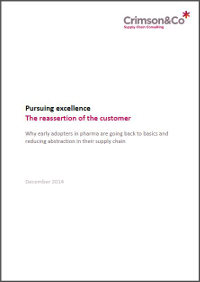The customer-producer relationship within the pharmaceutical supply chain is becoming so abstract that the producer is losing sight of the simple realities that underpin the business model, according to a new industry report from global supply chain consultancy Crimson & Co.
The report highlights an alarming trend whereby those at the sharp end, particularly the people who are developing, making, selling or moving are continually becoming marginalised, abstracting them further and further from the customer. Programme management and complex organisational structures continue to consume excessive amounts of management time.
In order to address this Kerry Pickstone, Head of Life Sciences at Crimson & Co says those within the pharmaceutical supply chain should actively be looking to reverse this trend and reengage with the customer:

‘Over the next five years, excellent pharmaceutical supply chains will be those who stand up and stop the trend. They will focus on getting closer to the customer and their own colleagues, doing the fundamentals right, while taking an end-to-end view of the supply chain.’
The report aims to highlight not only the critical challenges to reducing abstractions in the pharmaceutical supply chain, but also the changes which need to be made in order to reengage the customer-producer relationship. This includes:
- Understanding organisation complexity, particularly the need for the internal business customer to have the same characteristics as a real customer
- Reasserting the importance of content rather than process as a core management focus
- Re-evaluating the project portfolio – a recent study showed that 95% of all project time was spent simply coordinating activities. How can this be realigned?
- Development of employee and organisational skill sets, particularly moving away from an obsessive focus on functional skills to one that embraces the customer
Kerry concluded: ‘Firms should be looking to implement a simpler, more coherent and profitable way forward, even if it reduces the overall economies of scale that appear available from centralisation, integration and coordination. Ultimately, it’s time to go back and put the customer again at the heart of the business.’


